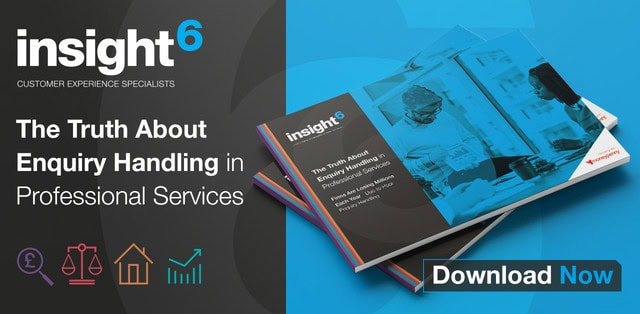How do you know when to invest in Customer Experience? What does such an investment look like? Is it training or measuring or just paying attention to the customer? And then, the million-dollar question, how do you know your investment in customer experience has actually worked? AND, is there a time you can stop investing in this valuable resource?
At insight6, our team of 24 Customer Experience Experts (CXDs) work across the UK and Ireland, with more than 1,000 businesses.
We asked them how they would answer these questions.
Our CXD team have very impressive senior management experience in customer centric companies from Tesler to Tescos, from Costa to Coke, Apple to Heineken.
What we discovered from our team of CXD’s can be summed up in six key findings:
1. One size does not fit all
The first step with any new client is to gain an understanding of the needs of the organisation. Some clients know exactly what is needed, for example, a team training programme or a competitor analysis. Other clients may need to gain an objective view on whether there is a customer experience issue to address. When a client does not know if there is an issue, the only way to find out is by asking either customers, the team or both! Whatever the client issue, whether it be high team turnover or low customer retention, the results of asking the right questions will always illuminate a path of action that will solve the problem. Simply having an open discussion with an expert will open up the world of CX and allow exploration into what can be achieved.
We had such a discussion with the CEO of a private school, which had a problem with their open days lacking purpose. Measuring the customer experience through insight6 CX reviews across all their open days led to identifying untapped specific sales opportunities that were immediately actioned by the whole team. This, in turn, led to an increase in conversion on new students of 49%! The return on investment on a school with £25K fees per annum is significant.
2. The time is right when you are ready for change
The only time to invest in Customer Experience is when you are prepared to take action. How many times have you decided to undertake research and used the report to fill a bookshelf, or attended a training course and, within a week, forgotten what you learnt? We all do it.
The truth is that you will know when it is time to invest in customer experience; it’s when you know you are ready and are open minded enough to embrace what comes next, and then make it happen.
Two live examples from our team are:
In an accountancy practice, staff focus groups and a team engagement survey were conducted across the business: the results were poor, as expected. The manner in which the results were presented, and the clarity of the next steps were too compelling for the managing partner to ignore. Within 6 months of the results and the actions of the management team, staff morale and retention had improved, and like for like sales had increased on the previous 6 months.
Conversely, a business had commissioned Customer Experience reviews (mystery shopping) to measure the customer’s perceptions of the service. KPI data was generated from the customer experience studies on sales, service and presentation over a series of months. The detailed gap analysis over time, clearly highlighted the need for sales skills training but the business was not ready to take the plunge. When measurement is used without the accompanying action, it is not possible to create the impact on the business and maximise your return.
Improving CX is about changing behaviour and that needs to be central to all activity.
3. Investment in Customer Experience is everything to do with the Customer
Take a look at your business through the lens of your customer, and you will see everything that needs to change! Keep the customer as a metaphoric ‘horse whisperer’ by having a continuous ‘feed in’ of how they see your business, from focus groups to CX reviews (mystery shopping), on-line immediate feedback, to Video mystery visits. The only thing that is vital, is that you listen to the ‘whispers’, and elevate their status in your business to the most important voice in your management team. One of our clients has an empty chair at their board table that represents the customer, so the customer’s perception can never be forgotten. This makes the point to the whole management team that the person in that chair is the one who needs to be most impressed with the decisions made in the meeting.
Our CXD’s recount some great examples where…
An optician’s practice committed to an ongoing programme of CX reviews (mystery shopping), Feedback Direct (real time customer feedback) and annual Focus Groups, which led to a change in strategic direction, continued investment and acquisition. All this was possible through deeply understanding the relationship with customers.
In a farm shop, the investment in understanding their customers better resulted in an observable increase in confidence in the management of the teams; they delivered great service and developed the art of selling through being ‘in service to customers’, rather than ‘hard selling’. The ROI was staggering.
4. Investing in the Catalysts to Customer Experience
Customer experience is not something that can be ‘given’ by a business. Customer experience is a subjective feeling that the customer has, which results from a series of events and encounters which leave an impression. This is called the Customer Journey. In order to create the blank canvas so that a customer journey can be identified, everyone in the organisation needs to see themselves as a catalyst to a great customer experience – from the leaders to the front-line team.
In a business that we worked with, the Customer Experience reviews (mystery shopping) and team engagement surveys revealed the need for sales training, coaching and mentoring for the whole team from the Senior leadership team to the salespeople. The team recognised the need to treat their customers better than their competitors, which resulted in an increase in sales and referrals.
A hospitality business was able to increase average spend by a fifth, and increase Customer Experience scores by 25%, as a result of fully engaging the team and management in the training and coaching programme.
5. ROI on Customer Experience is exponential
How do you measure the impact of making your team happier? What do you ask your customers to find out if they had a good experience? And how do you know if all your investment in your customers and team really did increase your sales?
Part of any customer experience project is to put ROI at the core of the work. It is vital that you can quantify the impact of the work and the money invested. The only place to start is by asking yourself questions about where your business is now and where you would like it to be and what would ‘great’ look like. Over 25 years, insight6 has developed robust tools to measure and quantify the impact of investing in customer experience for businesses, so you can know what works and what does not.
Examples:A retail and hospitality business wanted to understand what the increase would be in sales following a programme of CX reviews that identified an issue with the cafe team not upselling.
As a result, a sales training programme was delivered to the team. A carefully structured benchmark was created with the client on current customer spend levels and footfall before starting the project, so that any increases would be recognised and rewarded. At the end of a 12-month period, the spend levels increased as a result of 75% more customers responding to the service of the team and they purchased more product.
In a solicitor’s practice, a client journey mapping exercise led to the whole team becoming engaged in the customer experience. As a result, client retention and team productivity was increased. Just one client – who decided to stay with the practice after all – paid for the investment in the customer experience project 52 times over.
6. The magic sauce for customer experience is objectivity and expertise
The journey to being ‘great’ is continuous, especially as we live in a world where expectations from customers increase every single moment. Keeping up with customer expectations, knowing how to respond and being aware of what the priority is in your business, is a difficult task when you are ‘looking out’ from your business, as opposed to having the benefit of looking from outside in. Finding a trusted, objective and expert human adviser/partner is the magic sauce for knowing when and how to act with customer experience. Have you ever tried being your own therapist or coach? It does work, but only to the limit of what you have already experienced in your life. Gaining the insight of an expert will always allow you to step outside the boundaries of your own thinking, and experience a fresh, new way of looking at your business, inspiring you to go boldly into your future.

“Having the experience to mentor the managers to follow up the training is essential to create the transformation.” Harriet, Scotland
“We provided powerful insight with a large sample size which clearly showed the changes needed, those changes in this example created an extra £200k of income.” Graham Hill
So, is investing in Customer Experience a choice? The answer is not binary – the business needs to commit to changing and you need to find the expertise to rocket fuel your customer experience.



0 Comments